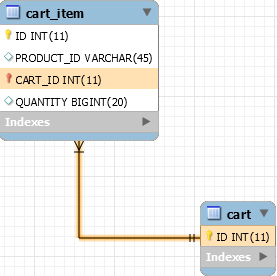I start showing you my scenario.
This is my parent object:
@Entity
@Table(name="cart")
public class Cart implements Serializable{
@GeneratedValue(strategy=GenerationType.IDENTITY)
@Id
@Column(name="id")
private Integer id;
@OneToMany(mappedBy="cart", fetch = FetchType.EAGER, cascade = CascadeType.ALL)
private List<CartItem> cartItems;
...
}
This is my child object:
@Entity
@Table(name="cart_item")
public class CartItem implements Serializable{
@GeneratedValue(strategy=GenerationType.IDENTITY)
@Id
@Column(name="id")
private Integer id;
@ManyToOne
@JoinColumn(name="cart_id", nullable=false)
private Cart cart;
...
}
As you can see looking at the database, in the table cart_item (child object) the field cart_id has a foreign key to the field id of the table cart (parent object).
This is how I save the object:
1) there's a restController that reads a JSON object:
@RestController
@RequestMapping(value = "rest/cart")
public class CartRestController {
@Autowired
private CartService cartService;
@RequestMapping(method = RequestMethod.POST)
@ResponseStatus(value = HttpStatus.CREATED)
public void create(@RequestBody CartDto cartDto) {
cartService.create(cartDto);
}
}
2) This is the CartService, that's just an Interface:
public interface CartService {
void create(CartDto cartDto);
}
This is the implementation of CartService:
import org.springframework.transaction.annotation.Transactional;
@Service
@Transactional
public class CartServiceImpl implements CartService {
@Autowired
private CartDao cartDao;
@Override
public void create(CartDto cartDto) {
cartDao.create(cartDto);
}
}
CartDao is just another interface, I show you only its implementation:
@Repository
public class CartDaoImpl implements CartDao {
@Autowired
private SessionFactory sessionFactory;
// in this method I save the parent and its children
@Override
public void create(CartDto cartDto) {
Cart cart = new Cart();
List<CartItem> cartItems = new ArrayList<>();
cartDto.getCartItems().stream().forEach(cartItemDto ->{
//here I fill the CartItem objects;
CartItem cartItem = new CartItem();
...
cartItem.setCart(cart);
cartItems.add(cartItem);
});
cart.setCartItems(cartItems);
sessionFactory.getCurrentSession().save(cart);
}
}
When I try to save a new cart and its cart_items I get this error:
SEVERE: Servlet.service() for servlet [dispatcher] in context with path [/webstore] threw
exception [Request processing failed; nested exception is
org.springframework.orm.hibernate5.HibernateOptimisticLockingFailureException: Object of
class
[com.depasmatte.webstore.domain.CartItem] with identifier [7]: optimistic locking failed;
nested exception is org.hibernate.StaleObjectStateException: Row was updated or deleted by
another transaction (or unsaved-value mapping was incorrect) :
[com.depasmatte.webstore.domain.CartItem#7]] with root cause
org.hibernate.StaleObjectStateException: Row was updated or deleted by another transaction
(or unsaved-value mapping was incorrect) : [com.depasmatte.webstore.domain.CartItem#7]
I suppose the error depends on the fact that when Hibernate try to save the a cart_item, the id of the cart doesn't exist yet!
What's the correct way to save a parent object and its childer in on shot? Thank you

